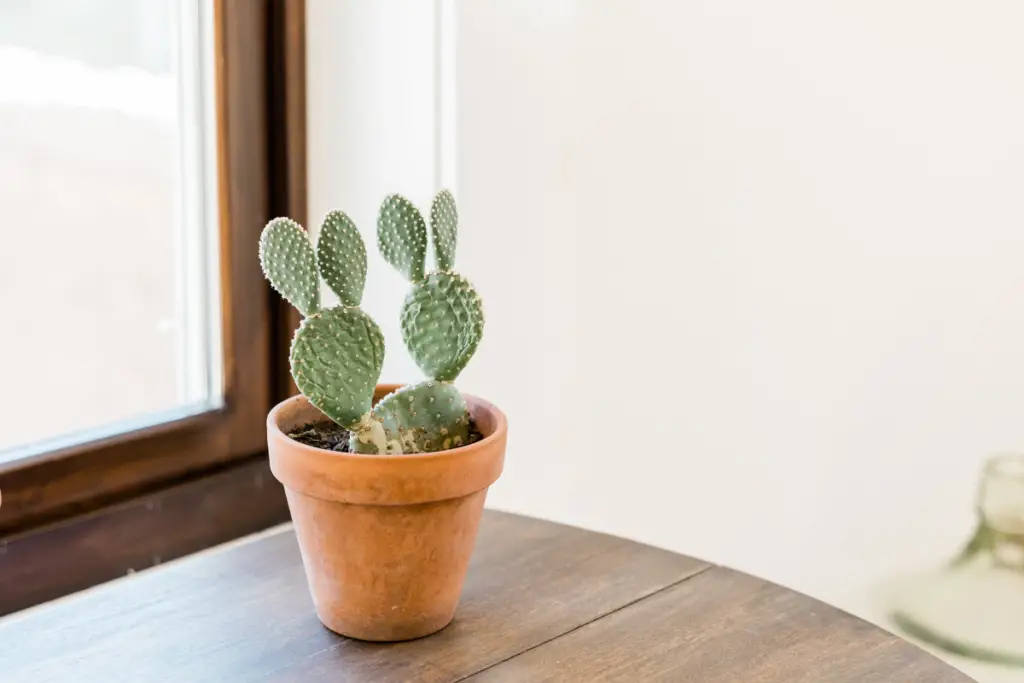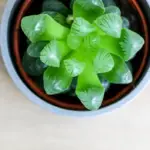Flowering cacti can add a unique and colorful touch to any indoor or outdoor space.
However, getting a cactus to bloom can be challenging, especially if it’s not in its native environment.
Fortunately, there are ways to encourage cacti to bloom all year round, even if they are not in their natural habitat.
One way to help cacti bloom is to simulate a desert environment. Desert cacti are used to intense sun and heat, with very little water.
From around September to April, keep desert cacti in bright, indirect sunlight at about 50° degrees Fahrenheit and water sparingly or not at all.
This will help them enter a dormant period, which is necessary for them to bloom.
Once spring arrives, gradually increase the amount of water and move them to a warmer and brighter location, such as near a south-facing window.

Table of Contents
Understanding Cactus Blooming
Cactus plants are known for their unique and beautiful flowers that bloom all over the plant, including the leaves, areoles, ribs, and warts.
However, getting a cactus to bloom can be a challenging task. In this section, we will discuss the cactus blooming cycle and the factors that influence blooming.
Cactus Blooming Cycle
Cactus plants have a specific blooming cycle that is influenced by several factors.
The blooming cycle can be divided into three stages:
- Dormancy: During this stage, the cactus plant is not actively growing or producing flowers. This stage typically occurs during the winter months when the plant is exposed to cooler temperatures and shorter days.
- Bud Formation: As the days get longer and warmer, the cactus plant will start to produce buds. This stage can last for several weeks to several months, depending on the species of cactus.
- Flowering: Once the buds have formed, the cactus plant will start to produce flowers. The flowering stage can last for several days to several weeks, depending on the species of cactus.
Factors Influencing Blooming
Several factors can influence the blooming of a cactus plant. These factors include:
- Light: Cactus plants require a specific amount of light to bloom. Too much or too little light can prevent blooming. Most cactus plants require at least 6 hours of direct sunlight per day to bloom.
- Temperature: Cactus plants require warm temperatures to bloom. Most cactus plants require temperatures between 60-90°F (15-32°C) to bloom.
- Watering: Overwatering or underwatering a cactus plant can prevent blooming. Most cactus plants require infrequent watering, with the soil drying out completely between waterings.
- Fertilizer: Fertilizing a cactus plant can help promote blooming. However, it is important to use a fertilizer specifically formulated for cactus plants.
By understanding the cactus blooming cycle and the factors that influence blooming, you can help your cactus plant produce beautiful flowers all year round.
Choosing the Right Cactus
When it comes to choosing a cactus that will bloom all year round, it’s important to consider the type of cactus and its ideal growing conditions.
Types of Flowering Cacti
There are many types of cacti that produce beautiful blooms throughout the year. Here are a few popular types to consider:
- Bolivian or Lobivia cacti: These cacti are known for their vibrant flowers, which come in a range of colors, including red, orange, and yellow. They prefer cool, dry conditions and well-draining soil.
- Hedgehog cactus varieties: These cacti produce flowers in shades of pink, purple, and red. They prefer bright, indirect light and well-draining soil.
- Golden Barrel cactus (Echinocereus): This cactus produces bright yellow flowers and prefers full sun and well-draining soil.
- Notocactus aka ball cactus: These cacti produce flowers in shades of yellow, red, and pink. They prefer bright, indirect light and well-draining soil.
Ideal Conditions for Each Type
Each type of cactus has its own ideal growing conditions. Here are some general guidelines to follow:
- Light: Most flowering cacti prefer bright, indirect light. However, some varieties, such as the Golden Barrel cactus, prefer full sun.
- Water: Cacti are drought-tolerant and prefer well-draining soil. Water sparingly, allowing the soil to dry out completely between watering.
- Temperature: Most flowering cacti prefer cool to moderate temperatures. Keep them away from drafts and extreme heat.
- Humidity: Cacti prefer low humidity levels. Avoid placing them in areas with high humidity, such as bathrooms or kitchens.
By choosing the right type of cactus and providing it with the ideal growing conditions, you can enjoy beautiful blooms all year round.
Caring for Your Cactus
When it comes to caring for your cactus, there are a few key factors that will help ensure it blooms year-round.
These factors include proper watering and feeding, providing the right amount of light and temperature, and pruning and re-potting as needed.
Watering and Feeding
Cacti are desert plants that are adapted to survive in arid conditions. As such, they do not require frequent watering and can actually be harmed by over-watering.
To ensure your cactus blooms, it is important to water it sparingly and only when the soil is completely dry.
When it comes to feeding your cactus, it is best to use a specialized cactus fertilizer that is high in phosphorus.
This will help encourage blooming and ensure your cactus is getting the nutrients it needs to thrive.
Light and Temperature
Cacti require a lot of bright, direct sunlight in order to bloom. However, it is important to be mindful of the temperature as well.
While cacti can tolerate high temperatures, they can be damaged by extreme heat or cold.
It is best to keep your cactus in a location where it will receive plenty of sunlight but will not be subjected to extreme temperatures.
Pruning and Re-potting
Pruning your cactus can help encourage blooming by removing dead or damaged growth and stimulating new growth.
It is important to use clean, sharp tools and to be careful not to damage the healthy growth of the plant.
Re-potting your cactus can also help encourage blooming by providing fresh soil and more room for growth.
It is best to re-pot your cactus in the spring, as this is when it is most actively growing and will be better able to recover from the stress of re-potting.
When re-potting, be sure to use a well-draining soil mix and a pot with plenty of drainage holes to prevent over-watering.
- INCLUDED IN PURCHASE | (6) assorted cactus varieties in 2 pot. Each plant may vary from pictures shown as succulents are hand selected based on season, size, health, and readiness.
- WATERING NEEDS | Cacti are very sensitive to overwatering, and damp soil can cause root rot. Dry out soil completely between waterings. Recommended amount is once every two weeks. Tip: top inch of soil should feel dry before watering again.
- FERTILIZING NEEDS | Fertilize every two to four weeks during spring and summer. Withhold fertilizer during the fall and winter months.
- SOIL | SUN | POTTING | Use well-draining soil. Regular potting soil or dirt wont do. Use cactus soil/mix potting soil with sand/pumice/perlite. Approximately 6 hours of sun per day. Gradually give plant more sunlight each day.
- CUSTOMER ASSURANCE | We strive to provide the highest quality plants delivered. If plants arrive damaged or unhealthy, we will issue a full refund or replace your pla
Prices pulled from the Amazon Product Advertising API on:
Product prices and availability are accurate as of the date/time indicated and are subject to change. Any price and availability information displayed on [relevant Amazon Site(s), as applicable] at the time of purchase will apply to the purchase of this product.
Encouraging Year-Round Blooming
Cacti are known for their beautiful and unique flowers, but getting them to bloom can be a challenge.
With the right care and attention, however, it is possible to encourage year-round blooming in your cactus.
Here are some tips to help you achieve this goal.
Manipulating Light Exposure
One of the most important factors in encouraging cactus blooming is light exposure. Cacti need plenty of bright, indirect sunlight to thrive, but too much direct sunlight can be harmful.
To encourage year-round blooming, it is important to manipulate the light exposure your cactus receives.
During the winter months, when daylight hours are shorter, it is important to provide your cactus with supplemental light.
You can do this by placing a grow light near your cactus for 12-14 hours a day. This will help to simulate longer days and encourage blooming.
During the summer months, when the sun is stronger, it is important to provide your cactus with some shade.
You can do this by placing your cactus in a location where it will receive bright, indirect sunlight for part of the day and shade for the rest of the day.
Adjusting Temperature
Temperature is another important factor in encouraging cactus blooming. Cacti thrive in warm, dry environments, but they also need a period of cooler temperatures to encourage blooming.
To achieve year-round blooming, it is important to adjust the temperature your cactus is exposed to.
During the summer months, it is important to keep your cactus in a location where it will be exposed to warm, dry air.
You can do this by placing your cactus in a sunny window or outside in a dry, desert-like environment.
During the winter months, it is important to provide your cactus with cooler temperatures.
You can do this by placing your cactus in a cooler room or by keeping it in a location where it will be exposed to cooler air at night.
Supplemental Feeding
Finally, supplemental feeding can also help to encourage year-round blooming in your cactus.
Cacti need a balanced diet of nutrients to thrive, and adding a cactus-specific fertilizer to their soil can help to provide these nutrients.
During the growing season, it is important to fertilize your cactus once a month with a balanced fertilizer that is high in phosphorus and potassium.
This will help to encourage blooming and keep your cactus healthy and strong.
By manipulating light exposure, adjusting temperature, and providing supplemental feeding, you can encourage year-round blooming in your cactus.
With the right care and attention, your cactus can bloom beautifully and bring joy to your home all year long.
Troubleshooting Common Issues
No Flowers
If a cactus is not blooming, it may be due to a lack of sunlight or nutrients. Cacti need plenty of sunlight to bloom, so make sure the plant is getting at least six hours of direct sunlight per day.
If the cactus is not getting enough sunlight, consider moving it to a sunnier location.
Cacti also need proper nutrition to bloom. If the soil is lacking in nutrients, consider fertilizing the plant with a balanced fertilizer.
However, be careful not to over-fertilize, as this can damage the plant.
Wilting or Discoloration
If a cactus is wilting or showing signs of discoloration, it may be due to overwatering or underwatering.
Cacti are adapted to dry environments, so they do not need to be watered frequently. Overwatering can cause root rot, which can lead to wilting and discoloration.
On the other hand, underwatering can cause the cactus to become dehydrated and wilt. To prevent these issues, make sure to water the cactus only when the soil is completely dry.
It is also important to use well-draining soil to prevent water from accumulating at the roots.
Pest and Disease Management
Cacti are generally resistant to pests and diseases, but they are not immune. Some common pests that can affect cacti include mealybugs, spider mites, and scale insects.
These pests can be removed with a cotton swab dipped in rubbing alcohol.
Cacti can also be susceptible to fungal infections, which can cause wilting and discoloration. To prevent fungal infections, make sure the soil is well-draining and avoid overwatering.
If a fungal infection does occur, treat it with a fungicide.
Conclusion
In conclusion, making cactus plants bloom all year round can be a challenging task. However, with the right care and conditions, it is possible to achieve a healthy, blooming cactus.
One of the most important factors to consider is the amount of light your cactus receives. Cacti require bright, direct sunlight to thrive and produce flowers.
If your cactus is not receiving enough light, it may not bloom at all.
Another crucial factor is watering. Overwatering can lead to root rot, which can prevent your cactus from blooming.
It is essential to water your cactus only when the soil is completely dry and to avoid getting water on the leaves or flowers.
Fertilizing your cactus can also help promote blooming. A balanced fertilizer, such as a 10-10-10 mix, can provide the necessary nutrients for your cactus to produce flowers.
However, it is important to follow the instructions carefully and not to over-fertilize.
In addition, keeping your cactus in a well-ventilated area can help promote blooming. Cacti require fresh air to grow and thrive, and stagnant air can prevent them from producing flowers.
- How to Dry Basil Leaves: A Professional Guide
- Is an Avocado a Fruit or Vegetable? Simple Answer and Explanation
- Does Pineapple Have Seeds? Exploring the Anatomy of Pineapples
- Blooming Through Winter: Can I Grow Vegetables Indoors in the Winter?
- What Can You Grow in a Greenhouse All Year Round: A Guide to Year-Round Greenhouse Gardening
- Are Blueberries Blue? Debunking the Myth of Their Color

















